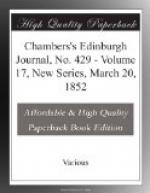It is said, that when women addict themselves to vice of any kind, they carry it to extravagance, and become far worse than bad men. In like manner, when the natural softness and amiability of the Hindoo character yield to the temptations of luxury and dominion, the individual grows into a tyrant as cruel and odious as any of those depicted in history. This apparent discrepancy has given rise to many speculative mistakes; but, in our opinion, it is as certain that the mass of the Hindoos are gentle and kindly in their nature, as it is that the mass of women are so. It is a curious thing to see the gallant sepoy on a march, attended by his pet lambs, with necklaces of ribbons and white shells, and ears and feet dyed of an orange colour. But even wild creatures are at home with the kindly Hindoo. Fluttering among the peasants threshing corn in a field, are flocks of wild peacocks, gleaning their breakfast; and in the neighbourhood of a village, a traveller can hardly distinguish between the tame and wild ducks, partridges, and peacocks. ‘There is a fine date-tree,’ says a recent writer, ’overhanging a kind of school, at the end of one of the streets in the town of Jubbulpore, quite covered with the nests of the baya bird; and they are seen every day, and all day, fluttering about in scores, while the noisy children at their play fill the street below, almost within arm’s reach of them.’
Almost all the natives of India are fond of rearing pet birds; and the pet is, more frequently than otherwise, a parrot, which is prized for its conversation. The same taste prevailed, we are told, in the fifteenth century, in the city of Paris, where talking-birds were hung out almost at every window. The authority says, that this was attended with rather an awkward result. ’Leading the public life they did, in which they were exposed to every sort of society, the natural morality of the birds was so far lost, that they had become fluent in every term of reproach and indecency; and thunders of applause were elicited among the crowd of passengers by the aptness of their repartees.’ In India, the taste is the same, but the habits different; a sketch of which we furnish from our Old Indian. The carpenter, she tells us, while planing the plank, which he holds between his toes, amuses himself by talking to his parrot. The shoemaker, while binding his slippers, or embroidering his rich velvet shoes, for the feet of some sable beauty, pauses every now and then, to listen to the chattering of his pet. The guala, on returning home, after disposing of his butter or buttermilk, first takes up some bamboo twigs, one of which is appropriated to each customer, and marking, by a notch with a knife, the quantity disbursed to each, turns, as a matter of course, to his favourite parrot, and either listens to the recital of his previous lessons, or begins to teach him some fresh invocation to some score of gods and goddesses. These men seldom condescend to teach their favourites anything




